Temple of Garni › Naram-Sin » Ancient origins
Articles and Definitions › Contents
- Temple of Garni › Antique Origins
- Naram-Sin › Who Was
Ancient civilizations › Historical and archaeological sites
Temple of Garni › Antique Origins
Definition and Origins

The Temple of Garni (Armenian: “ Garnu tacar ”) is located in the village of Garni in Kotayk Province, Armenia, and it was once a pagan temple dedicated to the Armenian sun god Mihr. Built in the middle of the 1st century CE, the Temple of Garni remarkably survived the destruction of pagan temples following Armenia's conversion to Christianity in the 4th century CE, and countless invasions and earthquakes until its collapse in 1679 CE. After continuous excavations in the late 19th and early 20th centuries CE, the Temple of Garni was reconstructed between 1969-1975 CE. Today, it is the only free-standing Greco- Roman structure in Armenia and seen by many as a potent symbol of Armenia's classical past as well as its deep historical ties to the civilizations of Greece and Rome.
HISTORY OF THE TEMPLE
The Temple of Garni is situated in a very strategic location, on a cliff, overlooking a range of the Geghama mountains as well as the Azat River near the Ararat Plain. Located 30 km (19 mi) from Yerevan, the Temple of Garni is quite near GeghardMonastery, which is only 11 km (7 mi) up the Azat River, and not too far from the ancient capital of Artashat. The site was inhabited in prehistoric times, and there is evidence that it was also used by the Urartians between the 8th-6th centuries BCE.
IT SEEMS PROBABLE THAT THE TEMPLE WAS FIRST CONSTRUCTED UPON THE ORDERS OF KING TIRIDATES I OF ARMENIA SOMETIME AROUND 70-80 CE.
Although the historical record concerning the Temple of Garni is limited, it seems probable that the temple was first constructed upon the orders of King Tiridates I of Armenia (r. 52-58 CE; 62-88 CE) sometime around 70-80 CE. This stands in contradiction to the opinion of the great Armenian historian Movses Khorenatsi who attributed the Temple of Garni's construction to Tiridates the Great (r. 287 CE - c. 330 CE) - Armenia's first Christian king - in the 3rd century CE. Other academics contend that it was not a temple but rather a former tomb to one of the pro-Roman kings of Armenia who lived in the 2nd century CE. This argument is sustained by the structural similarities between Garni and several mausolea in Asia Minor.
Tiridates I is primarily remembered in Armenian history for his visit to Naples and Rome in order to meet Emperor Nero (r. 54-68 CE) in 66 CE. The founder of the Arsacid dynasty of Armenia (52-428 CE), Tiridates I was a skilled diplomat, devout Zoroastrian, and lover of the arts. Although the Roman historian Tacitus claimed that Tiridates I was interested in all things Roman (Tacitus, Annals 15.5), it is more likely that Tiridates' exposure to and interest in Greco-Roman culture was deeply rooted given the fact that his mother was Greek and that he spoke Greek fluently. Curiously, Tacitus references the Temple of Garni, denoting it as the “Castellum Gorneae.”
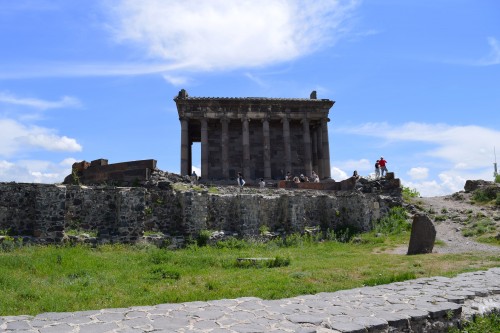
Side View of Garni Temple in Armenia
A Greek inscription uncovered by Martiros Saryan in 1945 CE at the Temple of Garni suggests that Tiridates I was the patron and founder of Garni Temple, but there are many possible interpretations and readings of this inscription. One interpretation cited by Dr. Vrej Nersessian translates the inscription as the following:
The Sun God Tiridates, uncontested king of Great Armenia built the temple and the impregnable fortress in the eleventh year of his reign when Mennieay was hazarapet [thousander, chiliarch] and Amateay was sparapet [general, commander]. (103)
The area surrounding the Temple of Garni functioned as a royal garrison and military fortress in ancient and medieval times. It was later surrounded by Roman baths dating from the 4th century CE in addition to a four-apsed church and a single-naved church, which both date from the 7th century CE. There remains considerable academic debate as to whether Garni functioned as a summer palace as well in Late Antiquity. Researchers are in agreement that there was also an immense defensive wall constructed of monolithic stones rather than mortar, which was built perhaps in the 1st century BCE. Many khachkars (memorial stele with a cross) are located beside the Temple of Garni. An Urartian cuneiform stone relating the conquest of the area surrounding Garni and dating to the reign of Argishti I (r. 785-763 BCE) is also positioned close to the temple.
After Armenia became Christian in the early 4th century CE, the Temple of Garni was spared thanks to the intercession of Princess Khosrovdoukht who was the sister of Tiridates the Great. At the time, Tiridates led a concerted effort to systematically destroy all of Armenia's ancient pagan temples. Due to its strategic importance, the area around the Temple of Garni was subjected to multiple invasions by Romans, Persians, Arabs, Byzantines, Turks, and the Mongols. The temple itself was repeatedly violated, and today visitors can see Arabic graffiti, which dates from the 9th-10th centuries CE.
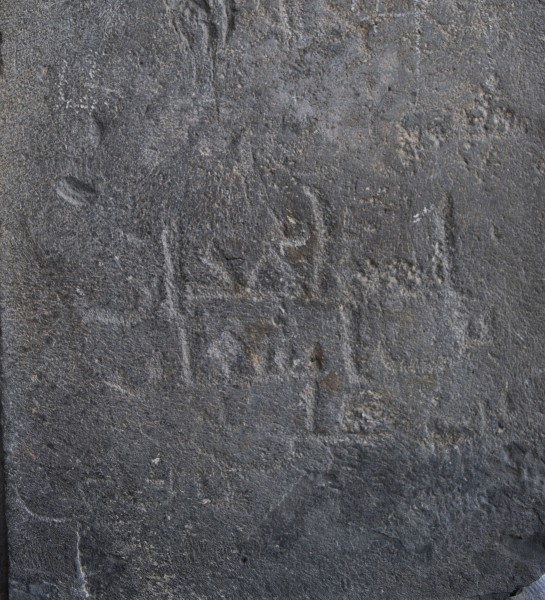
Arabic Graffiti at the Temple of Garni
The Ottoman Turks raided the environs of Garni in 1638 CE during the Ottoman–Safavid War of 1623–39 CE, causing much destruction. Following a catastrophic earthquake in 1679 CE, the Temple of Garni collapsed and was left in ruins for hundreds of years. It was only in the late 19th century CE that archaeologists began to explore the site, and it was Nikoraios Mar who took the initiative to amass and safeguard the stones of the fallen temple between 1909-1911 CE in the hopes of one day resurrecting the temple. Alexander Sarhinyan oversaw the restoration of the Temple of Garni between 1969-1975 CE while Armenia was under the control of the Soviet Union.
ARCHITECTURE
The Temple of Garni is the sole surviving pagan temple in Armenia and the only classical structure still standing in the country.Built on a podium, the temple is peripteral and oriented to the north. It is constructed of gray basalt that was quarried from the vicinity of Garni. The temple has 24 Ionic columns, which are 6.54 m (21.5 ft) high. Six are located in the front and the back parts of the temple, and eight on the sides. Some researchers believe that the columns originally came from Asia Minor and that they could symbolize the 24 hours of a day. The cella is about 7 m (23 ft) high, 8 m (26 ft) long, and 5 m (17 ft) wide. As it can only hold about 20-25 people inside, many historians and archaeologists believe it originally held a statue, perhaps of the sun god Mihr or Helios.
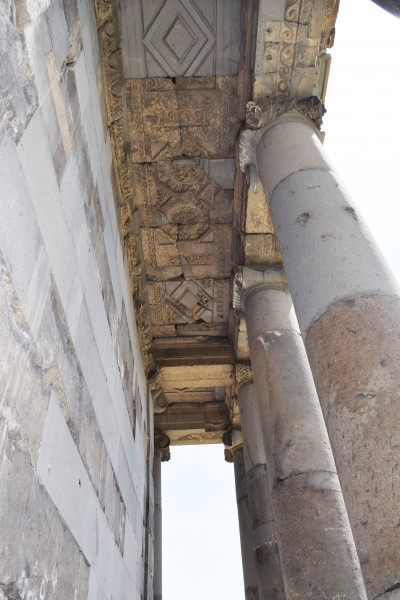
Ionic Columns at Temple of Garni
The equilibrium of elegant proportionality lends the Temple of Garni a concurrent impression of power and harmony. The temple is superbly decorated in the imperial Roman style. The architectural elements offer, however, certain variations that one recognizes in certain sculpted motifs, those representing lions in particular. The capitals themselves are singular; none are exactly identical with another. The friezes are dominated by acanthus leaves, which are sometimes mixed with laurels, oak leaves, and pomegranate trees.
The Roman baths found next to the Temple of Garni are built from brick and Armenian tuff (volcanic stone). They conform to the traditional layout found across the former Roman Empire and the Caucasus and are elegantly decorated with mosaics depicting mythological scenes.
This article was made possible with generous support from the National Association for Armenian Studies and Researchand the Knights of Vartan Fund for Armenian Studies.
Naram-Sin › Who Was
Definition and Origins

Naram-Sin (reigned 2261-2224 BCE) was the last great king of the Akkadian Empire and grandson of Sargon the Great(reigned 2334-2279 BCE) who founded the empire. He is considered the most important Akkadian king after Sargon (or, according to some, even ahead of him) and, along with his grandfather, became a near-mythical figure in Mesopotamian legend and story. Tales of the exploits of Naram-Sin and Sargon the Great were still being told in Mesopotamia thousands of years after their deaths.
Naram-Sin was the subject of many stories, legends, and songs but, interestingly, he became best known in legend through the story depicting him as the king who destroyed the Akkadian Empire by his impious acts, a story known as The Curse of Agade (written c. 2047-1750 BCE). There seems to be no historical truth to this legend, however, and it is thought that Naram-Sin was chosen as the main character because of his fame (as he was in works such as the Cutha Legend and The Great Revolt, neither of which are historically accurate either). The legends and stories all depict Naram-Sin as a supremely confident ruler, proud and arrogant. He is the first Mesopotamian ruler to have deified himself while he reigned and to have signed official documents with the seal of a god - the god of Akkad - himself. His reign marked the height of the Sargonic Dynasty and, after his death, the empire began to fall apart.
NARAM-SIN CLAIMED HIMSELF "KING OF THE FOUR QUARTERS OF THE UNIVERSE" AND BEGAN WRITING HIS NAME WITH A SIGN DESIGNATING HIMSELF A GOD ON EQUAL FOOTING WITH ANY IN THE MESOPOTAMIAN PANTHEON.
REIGN & MILITARY CAMPAIGNS
Following the death of Sargon, his son Rimush assumed the throne and ruled between 2279-2271 BCE. The cities of the empire rebelled after Sargon's death and Rimush spent the early years of his reign restoring order. He campaigned against Elam, whom he defeated, and claimed in an inscription to bring great wealth back to Akkad. He ruled for only nine years before he died and was succeeded by his brother Manishtusu (reigned 2271-2261 BCE). Manishtusu also had to put down rebellions upon his succession. He died after a reign of 15 years and was succeeded by his son Naram-Sin (also known as Naram-Suen). Like his father and uncle before him, Naram-Sin had to suppress rebellions across the empire before he could begin to govern (presumably the inspiration for the legend of The Great Revolt ) but, once he began, the empire flourished under his reign.
In the 36 years he ruled, he expanded the boundaries of the empire, kept order within, increased trade, and personally campaigned with his army beyond the Persian Gulf and, possibly, even to Egypt. The Victory Stele of Naram-Sin (presently housed in the Louvre) celebrates the victory of the Akkadian monarch over Satuni, king of the Lullubi (a tribe in the Zagros Mountains), and depicts Naram-Sin ascending a mountain, trampling on the bodies of his enemies, in the image of a god. Like his grandfather, he proclaimed himself "king of the four quarters of the universe" but, in a bolder move, began writing his name with a sign designating himself a god on equal footing with any in the Mesopotamian pantheon. The Sumerologist Samuel Noah Kramer describes Naram-Sin's rule thusly:
Naram-Sin raised Agade to new heights of power and glory...His military successes were numerous and prodigious: he defeated a powerful coalition of rebellious kings from Sumer and the surrounding lands; he conquered the region to the west as far as the Mediterranean Sea and Taurus and Amanus ranges; he extended his dominion into Armenia and erected his statue of victory near modern Dierbakir; he fought the Lullubi in the northern Zagros ranges and commemorated his victory with a magnificent stele; he turned Elam into a partially Semitized vassal-state and constructed numerous buildings in Susa ; he brought booty from Magan after defeating its king Manium, whom some scholars have identified with the renowned Menes of Egypt. No wonder that he felt himself powerful enough to add the epithet "king of the four quarters" to his titulary and that he was presumptuous enough to have himself deified as "the god of Agade" (62).
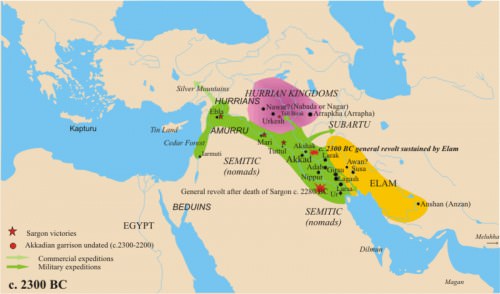 MAP OF THE AKKADIAN EMPIRE
MAP OF THE AKKADIAN EMPIRE

THE CURSE OF AGADE
In spite of his spectacular reign, considered the height of the Akkadian Empire, later generations would associate him with The Curse of Agade, a literary text ascribed to the Third Dynasty of Ur (2047-1750 BCE) but which could have been written earlier.The Curse of Agade is part of a Mesopotamian literary genre known as "naru literature ", which features a famous person (usually a king) from history as the main character in a didactic tale that most often concerns humanity's relationship with the gods. It tells the story of the destruction of the city of Akkad by the will of the gods owing to one king's impious act; and that king is Naram-Sin. It also very interestingly addresses the problem of seemingly meaningless suffering in its depiction of Naram-Sin's attempt to wrest a reason for his misery from the gods by force.
According to the text, the great Sumerian god Enlil withdrew his pleasure from the city of Akkad and, in so doing, prohibited the other gods from entering the city and blessing it any longer with their presence. Naram-Sin does not know what he could have done to incur this displeasure and so prays, asks for signs and omens, and falls into a seven-year depression as he waits for an answer from the god. Finally, tired of waiting, and enraged that he has received no answer, he draws up his army and marches on Enlil's temple at the Ekur in the city of Nippur which he destroys. He "sets his spades against its roots, his axes against the foundations until the temple, like a dead soldier, falls prostrate" (Leick, The Invention of the City, 106). This attack, of course, provokes the wrath not only of Enlil but of the other gods who send the Gutium, "a people who know no inhibition, with human instincts but canine intelligence and with monkey features" (Leick, 106) to invade Akkad and lay it waste. There is widespread famine after the invasion of the Gutians, the dead remain rotting in the streets and houses, and the city is in ruin and so, according to the tale, ends the city of Akkad and the Akkadian Empire, a victim of one king's arrogance in the face of the gods.
There is, however, no historical record of Naram-Sin ever reducing the Ekur at Nippur by force nor destroying the temple of Enlil, and it is thought that The Curse of Agade was a much later piece written to express "an ideological concern for the right relationship between the gods and the absolute monarch" (Leick, 107) whose author chose Akkad and Naram-Sin as subjects because of their, by then, legendary status. Naru literature was a very popular genre in Mesopotamia and often, it seems, the version of the past presented in these stories came to be accepted as actual history. According to historical record and archaeological evidence, Naram-Sin honored the gods, had his own image placed beside theirs in the temples, and was quite pious in spite of his habitual arrogance.
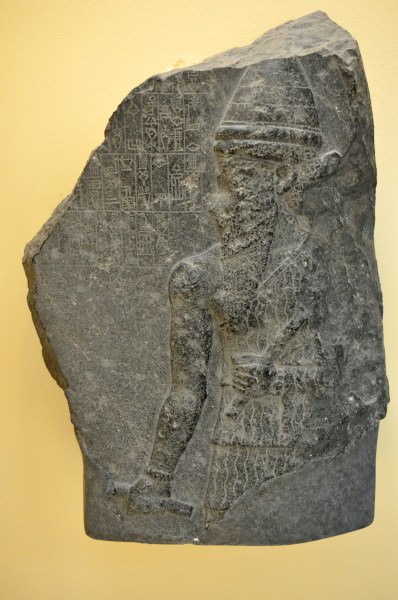
Stele of the Akkadian king Naram-Sin
DEATH & THE FALL OF THE EMPIRE
Naram-Sin died, presumably from natural causes, and was succeeded by his son, Shar- Kali -Sharri, who reigned from 2223-2198 BCE. Shar-Kali-Sharri's reign began as his predecessors had in that he, too, had to expend enormous effort in putting down revolts after his father's death but, unlike his predecessors, seemed to lack the ability to maintain order and was unable to prevent further attacks on the empire from without. Leick writes, "Despite his efforts and successful military campaigns, he was not able to protect his state from disintegration and, after his death, written sources dried up in a time of increased anarchy and confusion" (The AZ of Mesopotamia, 159). Interestingly, it is known that "his most important building project was the reconstruction of the Temple of Enlil at Nippur" and perhaps this event, coupled with the invasion of the Gutians and a widespread famine, gave rise to the later legend which grew into The Curse of Agade.
Shar-Kali-Sarri waged almost continual war against the Elamites, the Amorites, and the invading Gutians, but it is the Gutian Invasion in conjunction with climate change that caused famine, which has been most commonly credited with the collapse of the Akkadian Empire and the Mesopotamian dark age which followed. The events of Shar-Kali-Sarri's reign would later merge with the other Akkadian kings to form the basis of fables and stories told for thousands of years. As late as the 7th century BCE, the Assyrians were still reading and telling the stories of Sargon the Great and Naram-Sin. The library of Assyrian king Ashurbanipal (reigned 668-627 BCE) at Nineveh contained copies of these stories on clay tablets. When the invading armies of the Medes, Babylonians, and Persians destroyed the great Assyrian cities, they buried these tales beneath the rubble of the burning buildings and, in doing so, preserved them so that, thousands of years later, people are still today telling the tales of the Akkadian heroes and the great king, Naram-Sin.
LICENSE:
Article based on information obtained from these sources:with permission from the Website Ancient History Encyclopedia
Content is available under License Creative Commons: Attribution-NonCommercial-ShareAlike 3.0 Unported. CC-BY-NC-SA License